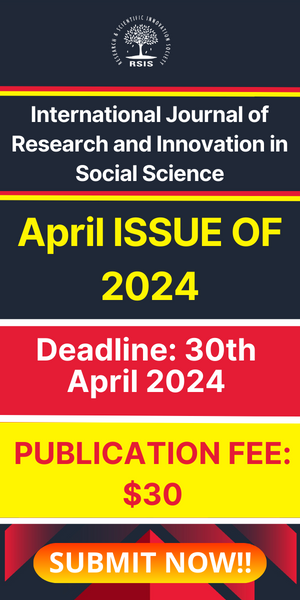- August 30, 2023
- Posted by: rsispostadmin
- Categories: Applied Science, IJRIAS
Post-Foundation Studies Using Integrated Geophysical and Geotechnical Methods at New Agbor Road, Uromi, Edo State, Nigeria
R.O. Ehidiamen1, I. Aigbedion2 and K.O. Ozegin3*
1Department of Sciences, NICTM Uromi, Edo State, Nigeria
2,3 Department of Physics, Ambrose Alli University Ekpoma, Edo State, Nigeria
*Corresponding author’s
DOI: https://doi.org/10.51584/IJRIAS.2023.8732
Received: 16 July 2023; Accepted: 28 July 2023; Published: 30 August 2023
Abstract: Globally, the incessant failure of buildings has drastically led to an increase in the loss of lives and properties, posing lots of concerns about the causes of these devastating effects. This research evaluates the immediate and remote causes of probable foundation failure on some buildings at Ohunyon Street, Uromi, Edo State, using integrated geophysical and geotechnical methods. By optimizing the measured field, calculating the apparent resistivity data, and interpreting the generated electrical resistivity tomography by using the SAS 1000 terrameter and RES2DINV software, a variation in soil resistivity and type was established. The geotechnical method required performing Atterberg limit-index studies on the gathered soil specimens in the region as well as geological laboratory grain size analyses. The pole-dipole results showed two weak zones and one moderately competent zone, whereas the dipole-dipole results revealed three primary layers: topsoil (sandy clay), clayey loam, and silty loam. The results also revealed regular clay permeation within the loam at depths ranging from 0.9 to 1.9 m, indicating yearly wetness, volumetric expansion, shrinkage, and uneven ground settlement. The geotechnical survey results provided useful information on both the textural soil test and the Casagrande soil analysis. All of the results were highly correlated, providing pertinent information regarding the factors responsible for the buildings’ failure and recommending that the foundations of these buildings be reinforced by piling to depths of 2 m (6.6 ft) below the ground surface in order to prevent future failures. This work has distinctly shown how integrated geophysical and geotechnical methodologies can potentially be used to evaluate subsoil competency.
Keywords: Casagrande soil analysis, Clay, ERT, Foundation failure, Soil integrity
I. Introduction
When a supporting section of a building develops defects that prevent it from supporting and transferring loads to a different part, the building has structural failures. The performance of the material used in a structural component breaks down, leading to structural failure. When a system or material is strained beyond its breaking point and develops cracks or deformation, the structure will fail (CIRIA, 2019). Structural failure and collapse all over the world have been traced to two phenomena: failure caused by any climate condition is classified as a natural phenomenon, while man-made phenomena are failures caused by general geology, incompetent materials, bad or poor structural designs, and poor engineering supervision. A poor foundation will prevent even a structure with superb design and construction from standing. Even though the building will support its weight, the soil that lies underneath it might not (Mohammed, 2017; Ozegin et al., 2013; Fajana et al., 2016). To avoid structural failure of buildings, it is therefore inherent to understand without assumption the geology of any land mass either proposed for engineering works or already utilized where probable signs of structural failure are being noticed, as it reveals the effects of climate in the area, determines the load bearing/uniform load transmitting capacity of the area, recommends suitable designs, and determines the nature of materials needed for the desired construction works. Geophysics can be used to study the geology of any area relating to engineering problems by employing either or both geotechnical and geophysical survey techniques in order to predict or image the subsurface of the earth.


